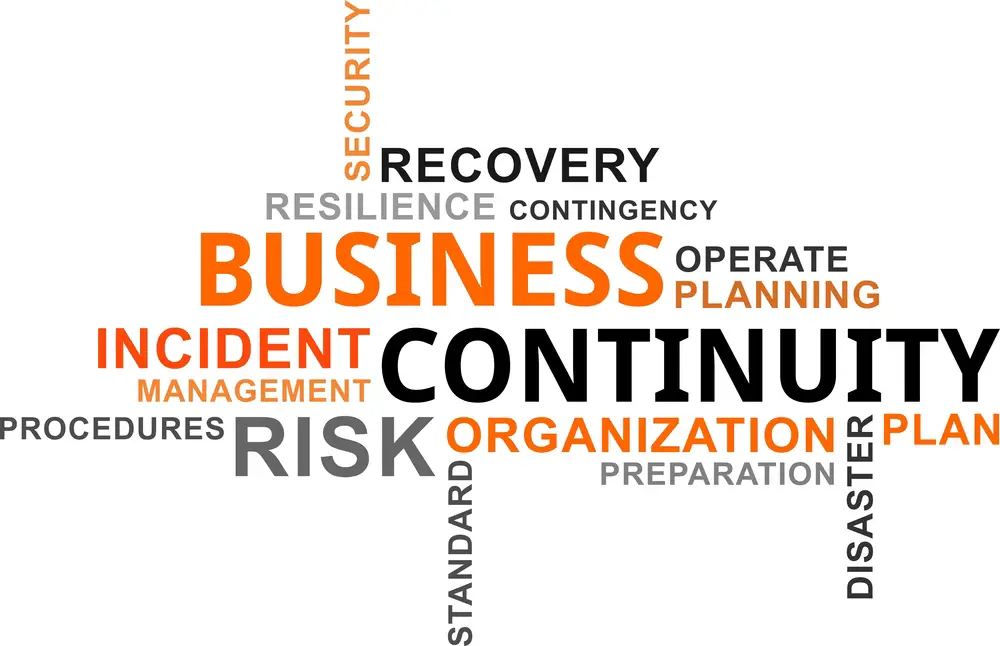A Business Continuity Management (BCM) System is a comprehensive process for managing an organization’s resilience and recovery from any disruptive event. It is designed to help organizations minimize the business processes’ impact of disruptions, such as natural disasters, supply chain issues, or cyberattacks, on their operations and customers.
An organized approach ensures that all areas of an organization are prepared for potential disruptions. This includes identifying critical processes, assessing risks, developing plans to respond to crises, and testing those plans on a regular basis.
The goal of implementing a BCMS is to ensure that your organization has the resources and procedures necessary to remain operational in the event of an emergency or disruption.
BCM systems are becoming increasingly important in today’s digital world as companies strive to maintain their competitive edge by protecting their data and operations from any kind of disruption. Let’s explore the components of a BCM system so you can determine if it’s right for your organization.
What is a business continuity management system?
Business continuity refers to the capability of organizations to maintain critical functions in the event of a disaster. Business continuity planning establishes risk management procedures and processes designed to prevent interruption to mission-critical services and restore optimum functions to the company.
Business continuity requires the most fundamental requirement for disaster recovery – in the least amount of time possible. A business continuity plan includes various unpredictable situations, including disasters, fire, diseases, outbreaks, and cyberattacks. Financial industry regulatory authority bodies require businesses to have BCPs.
Pandemics and other threats to your business can affect everyone. The Corona crisis demonstrated that a resilient, flexible response could be critical to an event. A BCM system allows your company to restore normal operation as soon as possible in the case of an interruption in service.
Continual business functions and operations are important. It guarantees that your firm can continue its regular business operations after an earthquake with minimal disruption. BCM is based on the belief that good response methods minimize damage caused by theoretical events.

What are the 3 main areas of business continuity management?
There are three main areas of focus regarding business continuity management: Disaster Recovery, Business Impact Analysis, and Risk Assessment & Management. Disaster Recovery plans cover contingencies, including natural disasters, cyber-attacks, utility outages, and other systemic risks.
Business Impact Analysis looks at how these disasters could potentially affect various aspects of a business, such as its customers or finances, allowing organizations to plan ahead for such disruptions.
Lastly, Risk Assessment & Management helps determine the strengths and weaknesses of an organization’s existing processes so appropriate changes can be made if necessary.
What is the primary purpose of business continuity management?
Its primary purpose is to ensure that an organization has the preparedness and capability to respond and recover from disruptive events, whether they are natural disasters or man-made challenges.
This involves physical assets and important intangible components such as data, technology systems and other organizational resources.
Why Is a BCMS Important?
A BCMS provides organizations with greater flexibility and resilience when facing unexpected events or disasters. By having specific procedures in place for responding to different types of crises, your organization will be better equipped to handle whatever comes it’s way.
Additionally, having a plan in place can help you save time and money by reducing downtime during emergencies or unexpected events. Finally, a BCMS can also help protect your reputation by demonstrating that you take your company’s security seriously and existing management systems.
The Components That Make up a BCM System
A BCM system has three main components: prevention, planning, and response. Prevention involves identifying potential risks and taking steps to mitigate them before they occur; planning involves creating strategies to handle disruptive events that cannot be prevented; and response involves executing plans when necessary.
These components work together to form a comprehensive approach to managing organizational resilience in the face of any type of disruption. The federal emergency management agency on its website provides details on BCMS.
Prevention Strategies
Prevention strategies involve identifying potential risks before they happen and minimizing those risks through preventative measures such as implementing firewalls or installing backup servers.
The goal of these preventive measures is twofold: first, they reduce the likelihood that an organization will experience a disruptive event; second, they minimize the damage caused by those events should they occur.
In addition to implementing preventive measures, organizations should also have procedures to monitor risk levels over time so that these threats can be identified early on.
Planning Strategies
Planning strategies involve creating detailed plans for how an organization will respond during a disruptive event. These plans should include details about who is responsible for particular tasks during an incident, what resources will be needed when each task needs to be completed;
How communication should be handled internally and externally throughout the entire process. Planning also involves regularly testing these plans so everyone knows exactly what needs to be done to respond quickly in an emergency.
Response Strategies
When responding to a disruptive event, an organization must execute its plan precisely to minimize any negative impacts on its operations or customers. This requires people trained to react appropriately during different types of incidents and have access to resources needed to implement the plan quickly and efficiently.
Response strategies also involve communicating regularly with stakeholders throughout the entire process so that everyone involved understands what is happening and why it is happening at all times during the incident resolution period.
Policies and strategies
It involves much more than simply responding to disasters or cyberattacks on a problem. In this regard, policies and procedures are designed, tested and used for incidents based on these policies and procedures.
A new policy defines scopes and key stakeholders, and management structures. The company must explain the need for Business Continuity and Governance at this stage. The process of creating a business continuity checklist is one of the components. Two others identify teams responsible for implementation. Governance helps to clarify an often chaotic situation that involves all involved.
Disaster recovery
How do businesses survive a disaster? Both of these plans are a set of objectives guiding operations and establishing rules for the restructuring. Disaster recovery involves a situation where an accident happened.
Disaster Recovery is an action or a team that comes about from a disaster. The results of work performed for the identification and remediation of the risks are described in detail below. Disaster recovery involves specific incidents rather than a larger plan. In response to a situation, it’s advisable to review and analyze the response to the situation and revise plans accordingly.
Business Impact Assessment
Impact Assessment is an inventorying process that can determine your company’s data, where that data is gathered, and how that information is retrieved. This process determines which data are critical and what the minimum amount of downtime will take.
While companies want 100% uptime, this rate isn’t always possible despite redundant system capabilities. This is also when your recovery objectives must be calculated – they are the maximum time required to restore an application to function in cases where services are temporarily lost.
Role of Communication & Management Business Continuity
Communication is crucial in maintaining business continuity. Communication is critical in ensuring transparent communication between clients, consumer groups and senior management.
Consistent communications are necessary for a successful incident. Messages always come from a single voice. Crisis management involves several types of communication and includes the production of tools that indicate progress, critical needs and problems. Communications may vary among different audiences.
Risk assessment
Risks can occur in many different ways. A business impact assessment will be carried out. Threats may involve bad actors, internal players and competitors in the marketplaces, and political and natural events.
Risk assessments assess various risks to businesses. It is important to identify potential threats as they may be extensive.
Incident Identification
In business continuity, the concept of the incident must always be understood. In policy documentation, the events must also clearly define the triggers and how the incident happened. The trigger actions needed to initiate the plan’s deployment and get the teams in motion.
Validation and testing
It requires continuous monitoring and measurement of risks. Once the mitigation plan is in place, it must be evaluated for proper functioning.
How Do I Implement A BCMS?
Implementing a Business Continuity Management System (BCMS) requires significant thought, planning, and organizational commitment. To ensure the success of your BCMS, you must consider all aspects, such as governance, policies, strategies, and active management of areas such as risk assessment
To begin the process, an executive champion or steering committee must be identified who has ownership and are accountable for ensuring the system is established across the wider business.
Then it will be important to carry out a business impact analysis with stakeholders to understand exactly what assets need protecting and the timeframes within which they need to be recovered.
Additionally, critical tasks should be outlined and assigned to ensure they can be performed promptly when required. Once these tasks have been carried out, there needs to be regular testing and review of processes, procedures, and plans so risks can always be managed adequately.
Implementing a BCMS requires careful planning and consideration of your organization’s unique needs. You should start by assessing the risks associated with different types of emergencies or disruptions and then develop plans to address those risks accordingly.
You should also consider which areas within your organization are most vulnerable and focus on developing robust response plans for these areas first.
Finally, once you have developed your plans, it’s important to test them regularly and update them as needed based on new information or emerging threats.
Importance of Business continuity management systems
A management system, or BCMS for short, is a management system that combines interrelated methods, procedures, and rules to ensure critical operations continue working in a disaster scenario and continuously develop and improve them.
Business continuity management consists of establishing a strategy for ensuring business operations remain operational or resume immediately following disasters. The plan also includes identifying potential threats like flooding, fires, and cyber attacks.
Business leaders should have a strategy for identifying a crisis before it occurs. Then test these methods for effectiveness, then periodically evaluate this process for its current status.
Protect your productivity with business continuity management and IT emergency management
Business continuity management helps prepare for possible problems and minimizes disruption. Using an effective emergency plan ensures everyone within an organization follows the plan if a crisis happens.
The emergency concepts and recovery plans allow you to return to productive operation in an emergency without interruption. The system will provide an integrated risk management system that gives you the legal confidence of your business and an edge in the marketplace.
React quickly in times of crisis with a business continuity management system
A business continuity Management System – BCM based on ISO22301 and ISO 27031 allows quick and correct responses for technical emergencies, IT emergency concepts and recovery plans.
Integrated into an existing Management system, BCMS integrates interrelated methods, procedures, and policies to ensure continuity.
Active crisis management with business continuity management
During the development phase, BCMS solutions are implemented for your business. The team will guide and develop with the assistance of a BCM officer and develop tests and training concepts. Furthermore, we can combine different analyses of threats for your BCMS to ensure optimum alignment with identified threats in your business plan.
BCMS: back to normal fast
During times of crisis, your goal is a quick recovery of business operations. Business continuity systems are useful for the task of ensuring business continuity. This technology which targets critical IT systems, allows for rapid and appropriate emergency response.
Conclusion
A business continuity management system (BCM) helps organizations stay resilient during times of disruption by providing preventive strategies for reducing risk levels, planning strategies for responding quickly if an incident does occur, and responding strategies for minimizing the harm caused by those incidents when they do happen.
Implementing such a system can help ensure that no matter what type of disruption occurs, your business can weather it successfully without too much impact on operations or customers. If your organization could benefit from more robust protection against unexpected disruptions, then investing in a BCM system may be worth considering!

Chris Ekai is a Risk Management expert with over 10 years of experience in the field. He has a Master’s(MSc) degree in Risk Management from University of Portsmouth and is a CPA and Finance professional. He currently works as a Content Manager at Risk Publishing, writing about Enterprise Risk Management, Business Continuity Management and Project Management.



